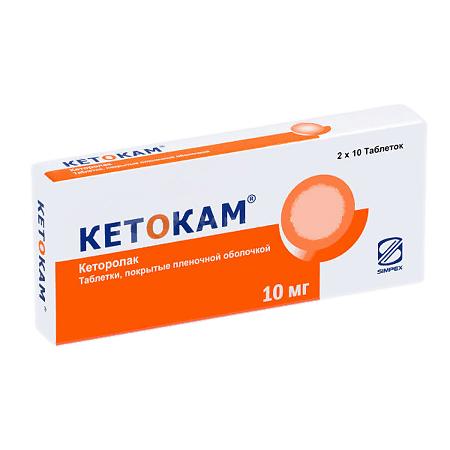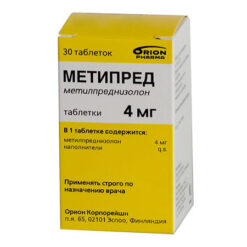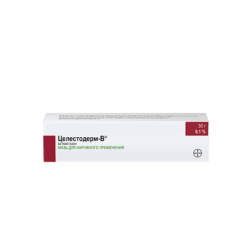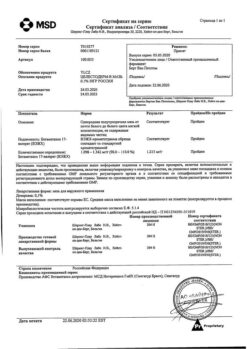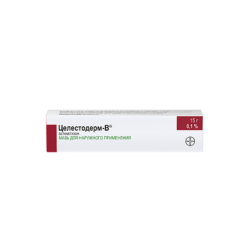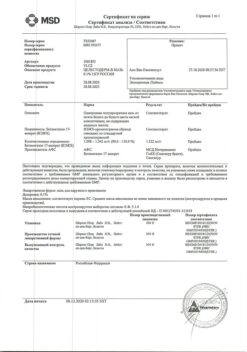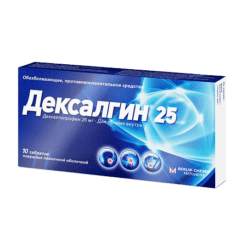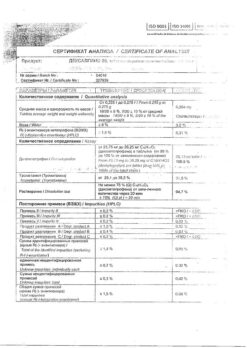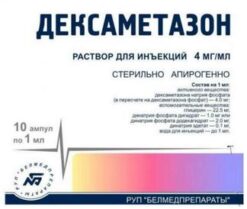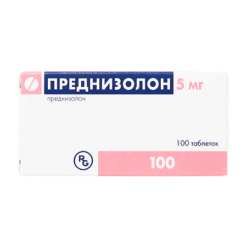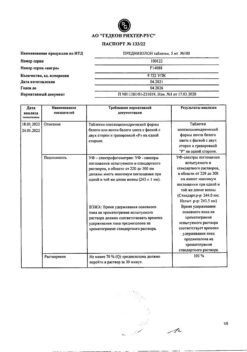No products in the cart.
Ketokam, 10 mg 20 pcs.
€1.00
Out of stock
(E-mail when Stock is available)
Description
Ketokam has a pronounced analgesic effect, it also has anti-inflammatory and moderate antipyretic effects. Mechanism of action is related to non-selective inhibition of COX activity, and COX2, catalyzing formation of PG from arachidonic acid, which play an important role in pathogenesis of pain, inflammation and fever. It is comparable with morphine in strength of analgesic effect and is significantly superior to other NSAIDs. After per oral and intravenous administration it is possible to observe analgesic effect in 0.5 and 1 hour respectively, maximal effect is reached after 1-2 and 2-3 hours.
Pharmacokinetics: absorption during oral administration is fast, bioavailability is 80-100%; in intravenous administration – complete and rapid. Cmax after oral administration of 10 mg is -0.82-1.46 µg/mL, Òcmax is 10-78 min; after 30 mg v/m administration Cmax is 1.74-3.1 µg/mL, 60 mg – 3.23-5.77 µg/mL, Òcmax is 15-73 min and 30-60 min respectively; Cmax after 15 mg v/m infusion is 1.96-2.98 µg/mL, 30 mg – 3.69-5.61 µg/mL. The binding to plasma proteins is 99%. Time to reach Css with parenteral and oral administration – 24 h when administered 4 times per day (above subtherapeutic) and is 0.65-1.13 mcg/ml, 1.29-2.47 mcg/ml when administered in v/v infusion of 15 mg – 0.79-1.39 mcg/ml, 30 mg – 1.68-2.76 mcg/ml; after 10 mg oral administration – 0.39-0.79 mcg/ml. The volume of distribution is 0.15-0.33 l/kg. In patients with renal insufficiency distribution volume of the drug may be increased by 2 times, and the distribution volume of its R-enantiomer – by 20%.
Liver function has no effect on T1/2.
In patients with impaired renal function at creatinine concentration in plasma 19-50 mg/l (168-442 µmol/l) the T1/2 is 10.3-10.8 h, in more severe renal failure – more than 13.6 h. Total clearance is 0.023 l/h/kg (0.019 l/h/kg in elderly patients), intravenous infusion of 30 mg – 0.03 l/h/kg, oral administration of 10 mg – 0.025 l/h/kg; in patients with renal insufficiency with creatinine concentration in plasma of 19-50 mg/l, intravenous infusion of 30 mg – 0.015 l/h/kg, oral administration of 10 mg – 0.016 l/h/kg. It is not excreted by hemodialysis.
Indications
Indications
Pain syndrome of severe and moderate severity: pain in the postpartum and postoperative period, trauma, toothache, cancer, myalgia, arthralgia, neuralgia, radiculitis, dislocations, sprains, rheumatic diseases.
Pharmacological effect
Pharmacological effect
Ketocam has a pronounced analgesic effect and also has anti-inflammatory and moderate antipyretic effects. The mechanism of action is associated with non-selective inhibition of the activity of COX and COX2, which catalyzes the formation of PG from arachidonic acid, which play an important role in the pathogenesis of pain, inflammation and fever. The strength of the analgesic effect is comparable to morphine, significantly superior to other NSAIDs. After intramuscular administration and oral administration, the onset of the analgesic effect is observed after 0.5 and 1 hour, respectively, the maximum effect is achieved after 1-2 hours and 2-3 hours.
Pharmacokinetics: Absorption when taken orally is rapid, bioavailability is 80-100%; with intramuscular injection – complete and rapid. Cmax after oral administration of 10 mg -0.82-1.46 mcg/ml, TCmax – 10-78 min; after intramuscular administration of 30 mg Cmax – 1.74-3.1 µg/ml, 60 mg – 3.23-5.77 µg/ml, TCmax – 15-73 min and 30-60 min, respectively; Cmax after intravenous infusion of 15 mg – 1.96-2.98 mcg/ml, 30 mg – 3.69-5.61 mcg/ml. Communication with plasma proteins – 99%. The time to reach Css with parenteral and oral administration is 24 hours when administered 4 times a day (above subtherapeutic) and is with intramuscular administration of 15 mg – 0.65-1.13 mcg/ml, 30 mg – 1.29-2.47 mcg/ml, with intravenous infusion of 15 mg – 0.79-1.39 mcg/ml, 30 mg – 1.68-2.76 µg/ml; after oral administration of 10 mg – 0.39-0.79 mcg/ml. Volume of distribution – 0.15-0.33 l/kg. In patients with renal failure, the volume of distribution of the drug may increase by 2 times, and the volume of distribution of its R-enantiomer by 20%.
Penetrates into breast milk: when the mother takes 10 mg of ketorolac, Cmax in milk is reached 2 hours after taking the first dose and is 7.3 ng/ml, 2 hours after taking the second dose of ketorolac (when using the drug 4 times a day) – 7.9 ng/l. More than 50% of the administered dose is metabolized in the liver with the formation of pharmacologically inactive metabolites. The main metabolites are glucuronides, which are excreted by the kidneys, and p-hydroxyketorolac. It is excreted 91% by the kidneys, 6% through the intestines.
T1/2 in patients with normal renal function is an average of 5.3 hours (3.5-9.2 hours after intramuscular administration of 30 mg, 4-7.9 hours after intravenous administration of 30 mg and 2.4-9 hours after oral administration of 10 mg). T1/2 increases in elderly patients and shortens in young ones.
Liver function has no effect on T1/2.
In patients with impaired renal function with a plasma creatinine concentration of 19-50 mg/l (168-442 µmol/l) T1/2 – 10.3-10.8 hours, with more severe renal failure – more than 13.6 hours. The total clearance with intramuscular administration of 30 mg is 0.023 l/h/kg (0.019 l/h/kg in elderly patients), intravenous infusion 30 mg – 0.03 l/h/kg, oral administration 10 mg – 0.025 l/h/kg; in patients with renal failure with a plasma creatinine concentration of 19-50 mg/l, with intramuscular administration of 30 mg – 0.015 l/h/kg, with oral administration of 10 mg – 0.016 l/h/kg. Not excreted by hemodialysis.
Special instructions
Special instructions
Use with caution in patients with impaired liver and kidney function, chronic heart failure, arterial hypertension, in patients with erosive and ulcerative lesions of the gastrointestinal tract and a history of bleeding from the gastrointestinal tract.
Ketorolac should be used with caution in the postoperative period in cases where particularly careful hemostasis is required (including after resection of the prostate gland, tonsillectomy, in cosmetic surgery), as well as in elderly patients, because The half-life of ketorolac is prolonged and plasma clearance may be reduced. In this category of patients, it is recommended to use ketorolac in doses close to the lower limit of the therapeutic range. If symptoms of liver damage, skin rash, or eosinophilia appear, ketorolac should be discontinued. Ketorolac is not indicated for use in chronic pain syndrome.
Impact on the ability to drive vehicles and operate machinery
If drowsiness, dizziness, insomnia or depression appear during treatment with ketorolac, special care must be taken when engaging in potentially hazardous activities that require increased attention and speed of psychomotor reactions.
Active ingredient
Active ingredient
Ketorolac
Composition
Composition
Active ingredient: ketorolac tromethamine 10.00 mg.
Excipients: microcrystalline cellulose 150.50 mg, corn starch (dried) 56.00 mg, magnesium stearate 1.00 mg, colloidal silicon dioxide 2.00 mg.
Coating composition: universal coating* 8.00 mg.
*- composition of the universal shell: hypromellose, titanium dioxide, polyethylene glycol, talc.
Contraindications
Contraindications
Hypersensitivity, hypovolemia (regardless of the cause), erosive and ulcerative lesions of the gastrointestinal tract in the acute stage, hypocoagulation (including hemophilia), bleeding or a high risk of their development, severe renal failure (plasma creatinine above 50 mg/l), liver failure, “aspirin” triad (a combination of bronchial asthma, recurrent nasal and paranasal polyposis sinuses and intolerance to ASA and drugs of the pyrazolone series), period of childbirth, lactation period, childhood (up to 16 years – safety and effectiveness have not been established).
With caution. Hypersensitivity to other NSAIDs, bronchial asthma, the presence of factors that increase gastrointestinal toxicity: alcoholism, smoking and cholecystitis; postoperative period, CHF, edema syndrome, arterial hypertension, renal dysfunction (plasma creatinine below 50 mg/l), cholestasis, active hepatitis, sepsis, SLE, concomitant use with other NSAIDs, old age (over 65 years), pregnancy.
Side Effects
Side Effects
From the respiratory system: rarely – respiratory failure, attacks of suffocation.
From the urinary system: rarely – increased frequency of urination, oliguria, polyuria, proteinuria, hematuria, azotemia, acute renal failure.
From the blood coagulation system: rarely – nosebleeds, anemia, eosinophilia, thrombocytopenia, bleeding from postoperative wounds.
From the cardiovascular system: rarely – bradycardia, changes in blood pressure, palpitations, fainting.
From the digestive system: possible nausea, abdominal pain, diarrhea; rarely – constipation, flatulence, feeling of gastrointestinal fullness, vomiting, dry mouth, thirst, stomatitis, gastritis, erosive and ulcerative lesions of the gastrointestinal tract, liver dysfunction.
From the central nervous system and peripheral nervous system: anxiety, headache, drowsiness are possible; rarely – paresthesia, depression, euphoria, sleep disturbances, dizziness, changes in taste, visual disturbances, motor disorders.
Metabolism: possible increased sweating, swelling; rarely – oliguria, increased levels of creatinine and/or urea in the blood plasma, hypokalemia, hyponatremia.
Allergic reactions: possible skin itching, hemorrhagic rash; in isolated cases – exfoliative dermatitis, urticaria, Lyell’s syndrome, Stevens-Johnson syndrome, anaphylactic shock, bronchospasm, Quincke’s edema, myalgia.
Other: possible fever.
Local reactions: pain at the injection site.
Interaction
Interaction
When ketorolac is used concomitantly with other NSAIDs, additive side effects may develop; with pentoxifylline, anticoagulants (including heparin in low doses) – the risk of bleeding may increase; with ACE inhibitors – there may be an increased risk of developing renal dysfunction; with probenecid – the plasma concentration of ketorolac and its half-life increase; with lithium preparations – a decrease in the renal clearance of lithium and an increase in its concentration in plasma is possible; with furosemide – reducing its diuretic effect.
When using ketorolac, the need for the use of opioid analgesics for pain relief is reduced.
Manufacturer
Manufacturer
Simpex Pharma Pvt. Ltd, India
Additional information
| Manufacturer | Simpex Pharma Pvt. Ltd. |
|---|---|
| Medication form | pills |
| Brand | #Н/Д |
Related products
Buy Ketokam, 10 mg 20 pcs. with delivery to USA, UK, Europe and over 120 other countries.

